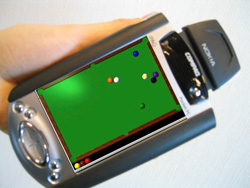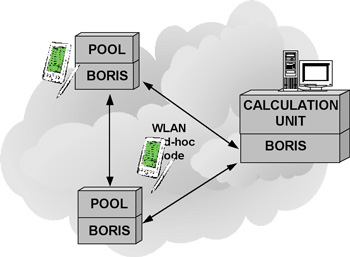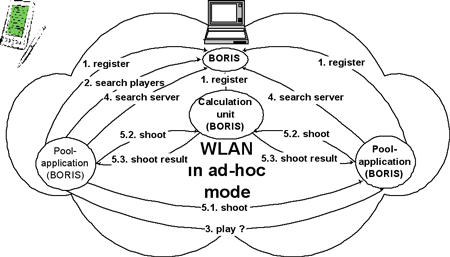|
|||||||
Mobile Gaming with Peer-to-Peer Facilitiesby Mika Pennanen and Kari Keinänen For today's rapidly growing mobile environments, VTT Information Technology has carried out research in order to provide middleware for the development of network games and other applications for various end-user devices (PDAs, mobile phones etc) and wireless networks (WLAN, Bluetooth etc). The key point is the addition of network facilities to existing applications, rather than the development of new applications. During the last decade, sales of mobile devices such as mobile phones have boomed worldwide. This is particularly true for 'smart phones', which feature calendars, e-mail, pictures, music and other applications (games, browsers etc), and belong to the fastest-growing new category of mobile phone. Only two years after the world's first third-generation mobile networks were launched, consumers in Japan are already embracing services such as video conferencing on models with built-in cameras and large colour screens. The wireless game industry is in a state of rapid growth. With the new technologies that are pushing the boundaries for mobile communication, we will see the game industry grow beyond its current revenue boundaries. Much of this will be due to the release of high-speed wireless data-transmission technologies, peer-to-peer (P2P) technology and Java-based games. These technologies will allow game designers to make products resembling those available on the wired Internet, naturally with respect to the restrictions of small mobile devices. These more sophisticated games will spread more widely than the current WAP and SMS games that are currently on the market. One of VTT's research areas is peer-to-peer technology and wireless networks. The basic idea in peer-to-peer technology is that two computing devices (peers) share resources and information with each other, having equal capabilities and responsibilities and with neither being specifically a client or server. In using P2P-style communication in wireless networks, private networks and IP addresses can cause some problems. Most of these occur while dealing with Network Address Translators (NATs), because private IP addresses cannot be seen from public or other private networks. Usually the solution can be found in a 'well-known' Internet server with a permanent IP address, which can 'introduce' the other two nodes. VTT's solution for P2P addressing problems in mobile gaming is Boris Object Request InfraStructure, known as BORIS for short. BORIS is a trader that introduces a simple and straightforward solution to the problems of resource naming and discovery. BORIS can also be used in areas other than gaming. Applications can exploit each other through BORIS middleware, which acts as an 'introducer' in pure P2P style without centralised or 'well-known' servers. IP addressing is not the only problem in P2P communication. As there are no central servers, problems have also arisen in controlling the information. Katherine Mieszkowski of Salon made an interesting comment on this: "P2P is a particularly comical new coinage for a business model since the phrase starkly points out that there's no middleman - so how can anyone possibly make any money?" However, P2P is a great asset, useful for applications requiring high computing capacity. In P2P, some tasks, such as extensive calculations, can be distributed into more powerful devices like desktop PCs. Applications on low-capacity mobile devices can exploit specific application-wide (and chargeable) services such as a distribution of computing capacity.
A general-purpose environment for the development of network games for mobile devices has been created in VTT. As an application, a Java-based game of pool for mobile devices (iPAQ) was demonstrated (see Figures 1 and 2). The VTT's demonstration uses peer-to-peer technology with a WLAN ad-hoc network. In this demonstration, applications of Pool are registered using the BORIS registration service (see Figure 3). Depending on device's capacity, information on registered applications or services can be maintained by a local device or a device behind the network. After registration, players can find names and locations of other players through BORIS. When a player is found, a P2P-style Pool game can be played between two iPAQ devices.
Due to the lack of floating-point units on the iPAQ devices used, and the heavy calculation required to determine the ball positions in Pool, the demonstration also contains a remote Pool calculation unit, which can be used to increase the utility of the game on low-capacity mobile devices. Future work will concentrate on extending these solutions and demonstrating them on several different mobile devices with different OSs and various wireless network technologies. Furthermore, we plan to extend and implement the business scenario with payable services for device users. Please contact: Kari Keinänen, VTT |
|||||||





